Concentration
Toddlers help a caregiver identify picture cards that show the same image or same color.



Be Prepared: Use one set of the egg and bird picture cards provided for this activity. There are six cards in a set. Three cards show an egg in one of three colors (red, blue, yellow) and three cards show a small bird in one of the same three colors. Offer the activity at a low table.
[Invite 3–4 toddlers to help you play a matching game.]
[Display the three cards that show an egg, one at a time. Put the three cards in a row in front of toddlers.]
Some of our cards show an egg. Here is an egg. Here is an egg. And here is another egg.
Each of our cards shows the same thing. The cards show an egg.
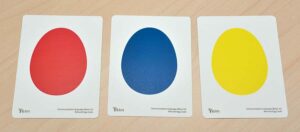 How are our pictures different?
How are our pictures different?
[Follow-up prompt, if needed: “Are the colors of our pictures the same or different?”]
Our pictures of an egg are in different colors. There is a red egg, a blue egg, and a yellow egg.
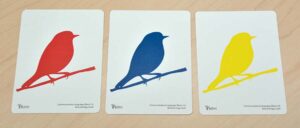 [Put the three cards showing an egg on your lap. Then display the three cards that show a bird, one at a time. Put the three cards in a row in front of toddlers.]
[Put the three cards showing an egg on your lap. Then display the three cards that show a bird, one at a time. Put the three cards in a row in front of toddlers.]
Some of our cards show a small bird. Here is a bird. Here is a bird. And here is another bird.
Each of the cards in front of us shows the same thing. The cards show a small bird. The bird is sitting on the branch of a tree.
What is different about the pictures we are looking at?
[Follow-up prompt, if needed: “Are the colors of our pictures the same or different?”]
Our pictures of a bird are in different colors. There is a red bird, a blue bird, and a yellow bird.
I am going to mix up our cards. Then I am going to try to put together the pictures of an egg and put together the pictures of a bird. I am going to pay attention to whether a picture shows a bird or shows an egg. I am not going to pay attention to the color of the picture.
Please watch to make sure I get all of the egg pictures together and all of the bird pictures together.
[Place the stack of six shuffled cards face down in front of you. Use the following approach to form two groups of cards on the table: a group of egg pictures and a group of bird pictures:
Put the fifth or sixth card you take from the pile in the wrong group without explanation. Wait for toddlers to notice your error. If the error is not identified by a toddler(s), ask “Did I put this picture where it belongs?” “Where does the card belong? Why?”]
Now please help me look at the cards a different way. I want to put together cards that are the same color. Remember, our cards show a picture in different colors. Some of our pictures are red, some of our pictures are blue, and some of our pictures are yellow.
I will look at the color of a picture. Then I will put the picture with another picture that shows the same color. I will not pay attention to whether the picture shows an egg or shows a bird.
I am going to mix up our cards and then look at the color of each picture.
[Shuffle the cards and place the stack of six cards in front of you, face down. Take one card at a time from the top of the stack and use procedures described above for putting together cards of the same color. There will be two cards in each of three small groups: red, blue, yellow.
For the second and each subsequent card, invite toddlers to say where the card goes on the table. Emphasize whether colors are the same or different.]
We used our cards to find things that were the same. This is called a match. First we paid attention to whether a picture was an egg or a bird. We put together pictures that were the same. Did we pay attention to the color of a picture when we put together pictures of an egg and pictures of a bird?
Then we looked at the color of a picture. We put together pictures that were the same color. Did we pay attention to whether a picture was a bird or an egg when we put together pictures of the same color?
Concentration
Toddlers practice paying attention to whether picture cards show the same image or the same color as part of a matching game played with caregiver guidance.



Be Prepared: This activity is for toddlers who participated in Option 1 or are familiar with how to play a matching game with cards. Limit the activity to 2–3 toddlers at a time so you can provide individualized support. The egg and bird picture cards for this activity are described in the Be Prepared section of Option 1. There are six cards in one set.
Invite 2–3 toddlers to play a matching game. Carefully show and describe the cards, focusing first on image (egg or bird) and then color, as suggested in Option 1. Emphasize how cards are the same and how cards are different. Remind toddlers that cards match when they show the same thing.
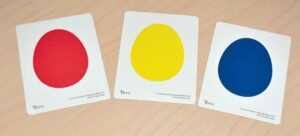 Explain that we will play our matching game two times. First we will put together cards that show the same picture. Give each toddler a stack of the six cards, face down. Invite toddlers to take one card at a time from their own pile of cards and put together cards that show the same thing. Pictures of an egg go together. Pictures of a bird go together. Remind toddlers that we are looking at the pictures on each card. We are not paying attention to color.
Explain that we will play our matching game two times. First we will put together cards that show the same picture. Give each toddler a stack of the six cards, face down. Invite toddlers to take one card at a time from their own pile of cards and put together cards that show the same thing. Pictures of an egg go together. Pictures of a bird go together. Remind toddlers that we are looking at the pictures on each card. We are not paying attention to color.
After each toddler has matched cards by picture, invite toddlers to put their cards in a pile in front of them, face down. Provide hands-on assistance in creating piles as needed. The cards do not need to be shuffled.
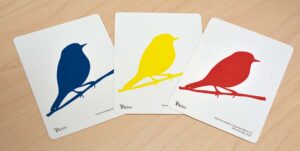 Explain that we will now try to match cards by color. Remind toddlers of the three colors by pointing to and naming each of the colors. Invite toddlers to take one card at a time from their own pile of cards and put together cards that show the same color. Remind toddlers that this time we are looking at the color of a picture. We are not paying attention to whether our card shows an egg or a bird.
Explain that we will now try to match cards by color. Remind toddlers of the three colors by pointing to and naming each of the colors. Invite toddlers to take one card at a time from their own pile of cards and put together cards that show the same color. Remind toddlers that this time we are looking at the color of a picture. We are not paying attention to whether our card shows an egg or a bird.
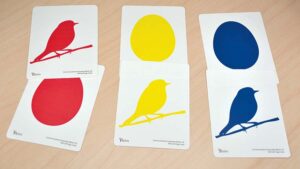 In each game round, provide verbal support as appropriate. Offer reminders that we are putting together cards that show the same picture or the same color. Use questions, such as “You’re looking at a picture of a bird. Does the picture of a bird go with another picture of a bird or with a picture of an egg?” Point out mismatches. Example: “Jadon, I see a picture of a bird next to a picture of an egg. Do the pictures show the same thing or different things?” Avoid telling a toddler where to put a card.
In each game round, provide verbal support as appropriate. Offer reminders that we are putting together cards that show the same picture or the same color. Use questions, such as “You’re looking at a picture of a bird. Does the picture of a bird go with another picture of a bird or with a picture of an egg?” Point out mismatches. Example: “Jadon, I see a picture of a bird next to a picture of an egg. Do the pictures show the same thing or different things?” Avoid telling a toddler where to put a card.
Conclude the session by encouraging toddlers to describe what they did. Remind toddlers that we paid attention by looking carefully.
Concentration
Toddlers practice paying attention to whether picture cards show the same image or the same color as part of a matching game played with minimal caregiver guidance.



Be Prepared: This activity is for toddlers who readily participated in Option 2. Limit the activity to five or fewer toddlers so you can provide guidance as needed. Although the activity emphasizes minimal caregiver assistance, it is important for each toddler to experience success in some aspect of a matching game. The egg and bird picture cards for this activity are described in the Be Prepared section of Option 1. There are six cards in one set.
Invite up to five toddlers to play a matching game. Show and encourage toddlers to describe the cards, focusing first on image (egg or bird) and then color, as suggested in Option 1. Expand toddlers’ descriptions by emphasizing how cards are the same and how cards are different. Remind toddlers that in a matching game we put together cards that are the same.
Explain that we will play two matching games. First we will match by the picture. We will put together cards that show an egg and put together cards that show a bird. Then we will match by color. We will put together cards that show the same color. Explain that you will watch and help if someone asks for help. You also will help each toddler get ready for the second matching game (focused on color). Urge toddlers to take their time. We can finish a matching game at different times. We are not in a race.
Provide each toddler with a set of the six cards in a stack, face down. Encourage toddlers to begin the first matching game (putting together eggs and birds).
Serve as an attentive observer. When a toddler is done matching cards by image, quietly help him/her put the cards into a stack in front of him/her, face down. Remind the toddler that now he/she is to put together cards that show the same color. Avoid drawing attention to a toddler’s completion of a matching game.
Experiences in sorting and matching different types of items are offered as Cognitive activities in the ELM Curriculum. Sorting and matching tasks involve concentration skills that also receive focused support in Self-Regulation activities. For example, support for paying close attention to characteristics of different pictures was offered in Block 16 (Self-Regulation).
A self-regulation challenge of the current activity is to focus on one of two features of a picture at one time. See Extra Support tips for ideas of how to help a toddler be successful with this challenge.
If a toddler finds it too challenging to focus on one feature (image or color) of a picture card in Option 2, offer the set of picture cards used in Block 16’s Self-Regulation activity (sea animals) or a set of picture cards that differ by one feature only. Providing an opportunity for success with a less challenging set of cards is far better than allowing a toddler to think that he/she cannot manage and also enjoy a matching game with picture cards.
Option 3 calls for each toddler to be on his/her own timeline; each toddler begins a second matching game (by color) when the first matching game (by image) is done. Most likely your help will be needed in putting cards in a stack in the transition from the first to the second matching game. It is best if you become aware of this transition by watching each toddler’s work and not encouraging toddlers to announce when they are done with one game and ready for another. Announcements of completion may distract other toddlers from concentrating on the cards and also might foster inappropriate competition.
Extra support
Enrichment
Materials Needed: see activity description
Set out several sets of materials for toddlers to sort and match. Examples: smaller and larger cardboard blocks, toy cars and toy trucks, toy plates and toy cups. You may wish to provide placemats to designate areas for putting together items that are the same. Describe and demonstrate how to sort and match the items. Toddlers may have their own ideas about what items go together. Talk with toddlers about their ideas and actions.
Materials Needed: see activity description
Preschool-age children may enjoy participating in any of the activity options. Offer a mobile infant several small, age-appropriate toys to hold and manipulate while watching toddlers participate in the activity options.